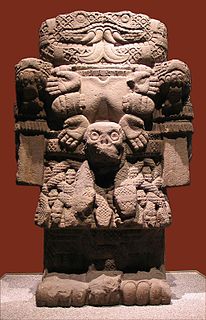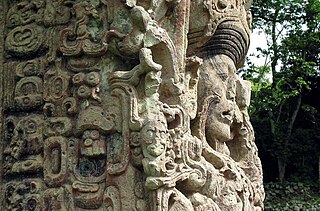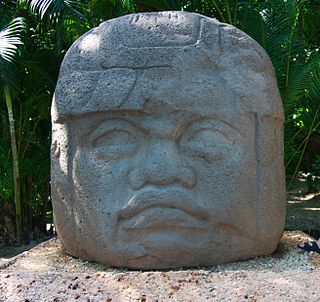 W
WAtlantean figures are carved stone support columns or pillars in the shape of fierce men in Pre-Columbian Mesoamerica. These figures are considered to be "massive statues of Toltec warriors". They take their name from the European tradition of similar Atlas or Atalante figures in classical architecture, which was then revived in the Renaissance and especially popular in Baroque architecture. Atlantean here refers to the figures' supporting posture, alluding to the load-bearing Titan Atlas, not Atlantis.
 W
WThe Aztec sun stone is a late post-classic Mexica sculpture housed in the National Anthropology Museum in Mexico City, and is perhaps the most famous work of Aztec sculpture. Its complex design and intricate glyphic language reflect that the stone is the product of a highly sophisticated culture. It measures 358 centimetres (141 in) in diameter and 98 centimetres (39 in) thick, and weighs 24,590 kg (54,210 lb). Shortly after the Spanish conquest, the monolithic sculpture was buried in the Zócalo, the main square of Mexico City. It was rediscovered on 17 December 1790 during repairs on the Mexico City Cathedral. Following its rediscovery, the sun stone was mounted on an exterior wall of the Cathedral, where it remained until 1885. Early scholars initially thought that the stone was carved in the 1470s, though modern research suggests that it was carved some time between 1502 and 1521.
 W
WChacmool is the term used to refer to a particular form of pre-Columbian Mesoamerican sculpture depicting a reclining figure with its head facing 90 degrees from the front, supporting itself on its elbows and supporting a bowl or a disk upon its stomach. These figures possibly symbolised slain warriors carrying offerings to the gods; the bowl upon the chest was used to hold sacrificial offerings, including pulque, tamales, tortillas, tobacco, turkeys, feathers and incense. In an Aztec example the receptacle is a cuauhxicalli. Chacmools were often associated with sacrificial stones or thrones.
 W
WThe Coatlicue statue is one of the most famous surviving Aztec sculptures. It is a 2.52 metre (8.3 ft) tall andesite statue by an unidentified Mexica artist. Although there are debates about what or who the statue represents, it is usually identified as the Aztec deity Coatlicue ("Snakes-Her-Skirt"). It is currently located in the National Museum of Anthropology in Mexico City. Originally displayed in the Mexica city of Tenochtitlan, the momentous statue was buried after the 1521 Spanish conquest of the city and excavated roughly 270 years later in 1790.
 W
WAltar Q is the designation given to one of the most notable of the rectangular sculpted stone blocks recovered at the Mesoamerican archaeological site of Copán, present-day Honduras.
 W
WThe Coyolxāuhqui Stone is a carved, circular Aztec stone, depicting the mythical being Coyolxāuhqui ("Bells-Her-Cheeks"), in a state of dismemberment and decapitation by her brother, the patron deity of the Aztecs, Huitzilopochtli. It was rediscovered in 1978 at the site of the Templo Mayor of Tenochtitlan, now in Mexico City. This relief is one of the best known Aztec monuments and one of the few great Aztec monuments have been found fully in situ.
 W
WThe Feathered Serpent was a prominent supernatural entity or deity, found in many Mesoamerican religions. It is still called Quetzalcoatl among the Aztecs, Kukulkan among the Yucatec Maya, and Q'uq'umatz and Tohil among the K'iche' Maya.
 W
WMaya stelae are monuments that were fashioned by the Maya civilization of ancient Mesoamerica. They consist of tall, sculpted stone shafts and are often associated with low circular stones referred to as altars, although their actual function is uncertain. Many stelae were sculpted in low relief, although plain monuments are found throughout the Maya region. The sculpting of these monuments spread throughout the Maya area during the Classic Period, and these pairings of sculpted stelae and circular altars are considered a hallmark of Classic Maya civilization. The earliest dated stela to have been found in situ in the Maya lowlands was recovered from the great city of Tikal in Guatemala. During the Classic Period almost every Maya kingdom in the southern lowlands raised stelae in its ceremonial centre.
 W
WThe Olmec colossal heads are stone representations of human heads sculpted from large basalt boulders. They range in height from 1.17 to 3.4 metres. The heads date from at least 900 BC and are a distinctive feature of the Olmec civilization of ancient Mesoamerica. All portray mature individuals with fleshy cheeks, flat noses, and slightly crossed eyes; their physical characteristics correspond to a type that is still common among the inhabitants of Tabasco and Veracruz. The backs of the monuments often are flat. The boulders were brought from the Sierra de Los Tuxtlas mountains of Veracruz. Given that the extremely large slabs of stone used in their production were transported over large distances, requiring a great deal of human effort and resources, it is thought that the monuments represent portraits of powerful individual Olmec rulers. Each of the known examples has a distinctive headdress. The heads were variously arranged in lines or groups at major Olmec centres, but the method and logistics used to transport the stone to these sites remain unclear. They all display distinctive headgear and one theory is that these were worn as protective helmets, maybe worn for war or to take part in a ceremonial Mesoamerican ballgame.
 W
WPotbelly sculptures,, are in-the-round sculptures of obese human figures carved from boulders. They are a distinctive element of the sculptural tradition in the southern Maya area of Mesoamerica. The precise purpose of potbelly sculptures is unknown, although they appear to have been the focus of public veneration and ritual directed by the ruling elite. Although this sculptural tradition is found within the southern Maya area, it has been recognized that the sculptures themselves are non-Maya.
 W
WThe Stone of Motecuhzoma I is a pre-Columbian stone monolith dating back to the rule of Motecuhzoma I (1440-1469), the fifth Tlaltoani (ruler) of Tenochtitlan. The monolith measures approximately 12 feet in diameter and 39 inches tall, and is also known as the Stone of Motecuhzoma Ilhuicamina, the Cuauhxicalli of Motecuhzoma Ilhuicamina, the Archbishop's Stone, the Ex-Arzobispado Stone, and the Sánchez-Nava Monolith. Historical sources refer to it simply as "temalácatl," literally meaning "round stone."
 W
WThe Stone of Tizoc, Tizoc Stone or Sacrificial Stone is a large, round, carved Aztec stone. Because of a shallow, round depression carved in the center of the top surface, it may have been a cuauhxicalli or possibly a temalacatl. Richard Townsend maintains, however, that the depression was made in the 16th century for unknown purposes.
 W
WThe Teocalli of the Sacred War is the name given by archaeologist Alfonso Caso to a monolithic pre-Columbian miniature of an Aztec temple, thought by some to have served as a throne for Motecuhzoma II.